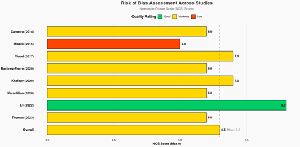Revealing the Atopic Nexus: A Systematic Review and Meta-Analysis of Pityriasis Alba
Authors
##plugins.themes.bootstrap3.article.main##
Abstract
Background: Pityriasis alba (PA) is a benign and common dermatosis predominantly occurring in children in association with atopy. Although it is very common, there is limited systematic investigation into its association with atopic dermatitis (AD) and other atopic disorders. Aim and Objective: The aim of this research is to determine the prevalence of pityriasis alba (PA) and its association with atopy, with the question in mind: "What is the strength of the association between pityriasis alba and atopy in studies from 2014 to 2023?". Methods: Systematic review was performed using PubMed, Embase, and Scopus for 2014-2023 studies according to PRISMA 2020 guidelines. Full-text PDF studies with focus on PA prevalence or atopy association were included. Four studies with atopy data were meta-analysed using a random-effects model. Results: We had eight studies, and three of them were included in meta-analysis. The overall prevalence of atopy in PA patients was 0.66 (66%), 95% CI: 0.62-0.70, I² = 0%. PA was always linked with atopy, especially AD. Conclusion: PA is highly correlated with atopy, thus supporting its status as a minor manifestation of AD. Moreover, further large-scale studies are required to support this correlation.
##plugins.themes.bootstrap3.article.details##
Copyright (c) 2025 Prathyusha Prabhakar, Archana Suresh, Darsan S, Noula Rahim, Jamila Hameed

This work is licensed under a Creative Commons Attribution 4.0 International License.
Creative Commons License All articles published in Annals of Medicine and Medical Sciences are licensed under a Creative Commons Attribution 4.0 International License.
[1] Givler DN, Saleh HM, Givler A. Pityriasis alba. InStatPearls [Internet] 2024 Jan 25. StatPearls Publishing.
[2] Shashikumar MB, Harish MR, Naidu HM, Vinaykumar MV, Deepadarshan K, et al. Profile of Micronutrients in Patients Presenting with Pityriasis Alba in a Tertiary Care Center: A Case–control Study. Clinical Dermatology Review. 2024 Jul 1;8(3):235-9.
[3] Abdelwahab AA. Pityriasis Alba: An update on the epidemiologic features, etiopathogenesis and management. Sohag Medical Journal. 2023 Jan 1;27(1):6-12.
[4] Hanifin JM, Rajka G. Diagnostic features of atopic dermatitis. Acta Derm Venereol Suppl (Stockh). 1980;92:44–7.
[5] Carneiro FR, Amaral GB, Mendes MD, Quaresma JA. Tissue Immunostaining for Factor XIIIa in Dermal Dendrocytes of Pityriasis Alba Skin Lesions. An Bras Dermatol. 2014;89(2):245-8.
[6] Quatresooz P, Paquet P, Hermanns-Lê T, Piérard GE. Molecular mapping of factor XIIIaenriched dendrocytes in the skin (reviem). Int J Mol Med. 2008;22:403-9.
[7] Miazek N, Michalek I, Pawlowska-Kisiel M, Olszewska M, Rudnicka L. Pityriasis Alba—Common Disease, Enigmatic Entity: Up-to-Date Review of the Literature. Pediatr Dermatol. 2015;32(6):786-91.
[8] VARGAS‐OCAMPO FR. Pityriasis alba: a histologic study. International journal of dermatology. 1993 Dec;32(12):870-3.
[9] Vinod K, Kumar S, Yadav AK. Role of Trace Elements in Pityriasis Alba. J Clin Diagn Res. 2017;11(5):BC01-BC04.
[10] Jadotte, Y.T.; Janniger, C.K. Pityriasis alba revisited: Perspectives on an enigmatic disorder of childhood. Cutis 2011, 87, 66–72.
[11] Martinez-Fierro ML, Cabral-Pacheco GA, Garza-Veloz I, Campuzano-García AE, Díaz-Alonso AP, Flores-Morales V, et al. Expression Levels of Inflammatory and Oxidative Stress-Related Genes in Skin Biopsies and Their Association with Pityriasis Alba. Medicina (Kaunas). 2020;56(7):359.
[12] In SI, Yi SW, Kang HY, Lee ES, Sohn S, Kim YC. Clinical and histopathological characteristics of pityriasis alba. Clinical and experimental dermatology. 2009 Jul 1;34(5):591-7.
[13] Khafagy GM, Nada HR, Rashid LA, El-Samanoudy SI, Abd El-Sattar EM. Role of trace elements in pityriasis Alba. J Trace Elem Med Biol. 2020 May;59:126422.
[14] Guareschi E, Di Lernia V. Infantile pityriasis alba and comorbid disorders. Pediatric Health. 2009 Feb 1;3(1):75-9.
[15] Karanfilian KM, Behbahani S, Lambert MW, Alhatem A, Masessa J, Espinal-Mariotte J, et al. The Pathophysiology of Pityriasis Alba: Time-Dependent Histologic Changes. Clin Dermatol. 2020;38(3):354-6.
[16] Lv Y, Gao Y, Lan N, Sun M, Zhang C, Gao J, et al. Analysis of Epidemic Characteristics and Related Pathogenic Factors of 2726 Cases of Pityriasis Alba. Clin Cosmet Investig Dermatol. 2022;15:203-9.
[17] Thomas IN, James JJ, Bala A, Mohan S, Dogiparthi S, Shanmugam NP Sr. Usage of Dermoscopy as an Effective Diagnostic Tool in Pityriasis Alba: A Prospective Observational Study Among Children in a Suburban Hospital in South India. Cureus. 2023;15(6):e40271.

